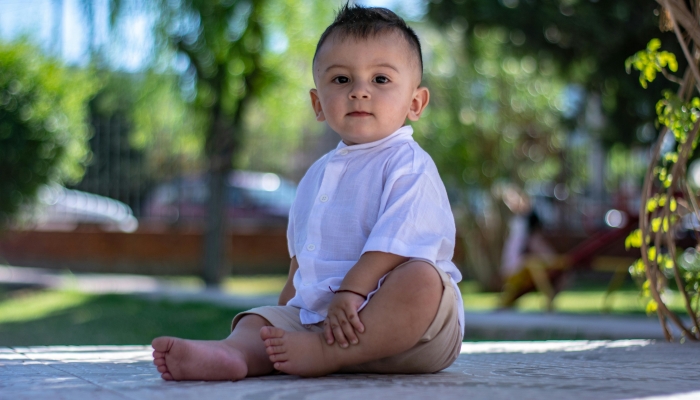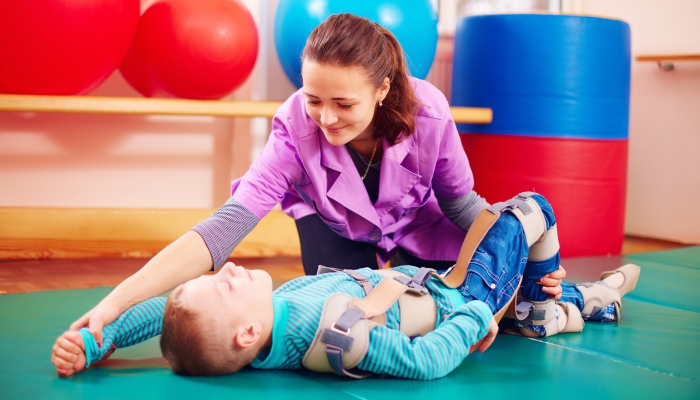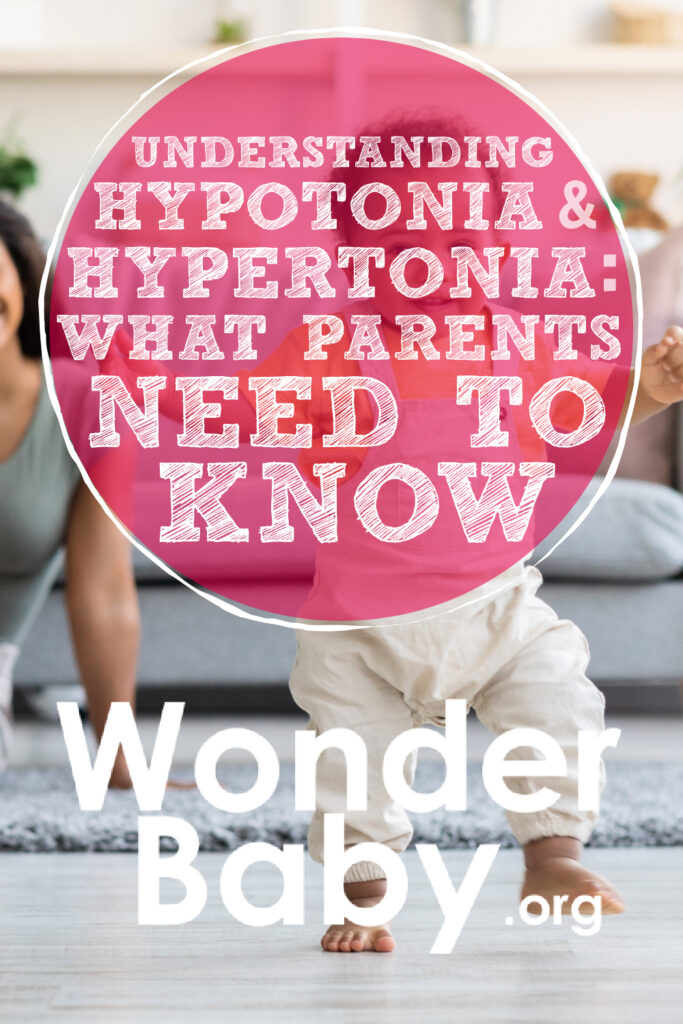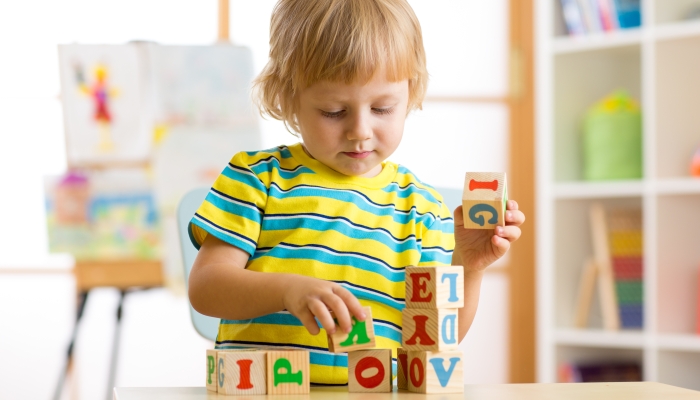Understanding Hypotonia & Hypertonia: What Parents Need to Know

- Hypotonia is marked by a lack of muscle resistance or tension during movement.
- Hypertonia can be described as an inability to let muscles relax during movement.
- Altered muscle tone may affect several key areas of childhood development.
- Therapies and treatments are available to help address issues that arise from decreased or increased muscle tone.
The human brain is a truly remarkable structure. It’s been described as the world’s most powerful computer, capable of sending, receiving, and interpreting untold amounts of input from inside and outside the body every second.
The central nervous system (CNS), which includes nerves and the spinal cord, connects all the nerves in the body to the brain via a system of routes or pathways. Systems that also control and manage muscle tone (the amount of resting tension inside a muscle) run concurrently with the nervous system.
At times, conditions or injuries will disrupt the communication route between the brain, muscles, and nerves. Signals from the brain are “lost in translation,” meaning that muscles and/or nerves are unable to receive or perform the message sent from the brain.
When an injury or condition affects the ability to send a signal from the brain to these nerves, it can look like hypertonia or hypotonia—an alteration in muscle tone.
Raising a child with these conditions poses many questions. By understanding hypertonia and hypotonia, parents can help their children achieve their healthy best.
What Is Hypotonia?

Throughout the newborn period and infancy, muscle tone is one of many indicators of your child’s overall health status. Low, decreased, or poor muscle tone is commonly known in the medical community as hypotonia11. Madhok, S. S.. Hypotonia. StatPearls [Internet]. 2022. https://www.ncbi.nlm.nih.gov/books/NBK562209.
Hypotonia is usually associated with other neurologic or genetic conditions and is rarely seen as the sole diagnosis.
Characteristics
When a healthcare provider is considering a diagnosis of hypotonia, it’s important to remember that this professional will evaluate your baby’s muscle tone as it is seen most of the time. Decreased muscle tone can be a common finding in certain settings, like when your little one is asleep or not feeling well.
However, to accurately diagnose this disorder, your child’s doctor may ask you to describe your child’s posture or movements as you observe them under normal conditions.
The general population may describe newborns and infants with hypotonia as having “floppy infant syndrome22. Kaler, J., Hussain, A., Patel, S., & Majhi, S.. Neuromuscular Junction Disorders and Floppy Infant Syndrome: A Comprehensive Review. Cureus. 2020. https://doi.org/10.7759/cureus.6922,” meaning their joints show little to no resistance when moved.
While this term may seem unkind, it tends to be a rather accurate description of what it feels like to handle or lift an infant with this condition.
Causes
Experts from Boston Children’s Hospital33. Muscle Weakness (Hypotonia). Boston Children’s Hospital. https://www.childrenshospital.org/conditions/muscle-weakness-hypotonia report that hypotonia can be caused by a variety of disorders that affect the central nervous system (including the brain and spinal cord), as well as muscular and genetic conditions.
These include diagnoses such as:
- Cerebral palsy
- Down syndrome
- Muscular dystrophy
- Prader-Willi syndrome
- Marfan syndrome
- Tay-Sachs disease
Symptoms
While hypotonia is usually noted in the newborn period or early infancy, the underlying condition(s) causing decreased muscle tone may change or progress over time.
As a result, other signs of this disorder may appear as your child grows.
Experts at the Cleveland Clinic44. Hypotonia in Babies. Cleveland Clinic. 2021. https://my.clevelandclinic.org/health/diseases/22223-hypotonia-in-babies describe the following symptoms of hypotonia for infants and older children:
| Infants | Older children |
| Unable to lift head or control neck muscles | Difficulty sitting upright |
| Feels limp when held | Delayed crawling |
| Cannot place weight on their legs | Delayed walking |
| Arms and legs tend to hang straight at their sides without bending at their joints | Delayed vocalizing or saying their first words |
| Difficulty swallowing or sucking | Difficulty feeding themselves independently |
| Weak cry | Poor posture |
| Signs of muscle weakness (such as difficulty or inability to lift or move objects) |
Promptly contact your child’s doctor if you have concerns about your little one’s motor skill development or if they’re not achieving gross motor milestones.
What Is Hypertonia?

If hypotonia is seen as a notable decrease in muscle tone, hypertonia can be viewed as its opposite.
Characteristics
Infants with hypertonia demonstrate a marked rigidity or resistance to movement55. Jušić, A.. Differential diagnosis and treatment of muscle hypertonia as practiced in Zagreb’s Centre/Institute for Neuromuscular Diseases. Acta myologica : myopathies and cardiomyopathies : official journal of the Mediterranean Society of Myology. 2013. https://www.ncbi.nlm.nih.gov/pmc/articles/PMC4006277 of their joints.
The general population might describe the movement of hypertonic babies and children as “stiff” or “mechanical” because of their inability to move fluidly due to their significantly increased muscle tone.
Causes
As with hypotonia, there may be a variety of neurologic, muscular, and/or genetic conditions that may cause increased muscle tone in young children.
Injury or damage to the brain or central nervous system may also explain hypertonia.
According to the Cleveland Clinic66. Hypertonia in Babies. Cleveland Clinic. 2021. https://my.clevelandclinic.org/health/diseases/22231-hypertonia-baby, these diagnoses may include:
- Congenital brain or central nervous system malformations (like hydrocephalus)
- Birth-related injury (such as lack of oxygen during the delivery process)
- In-utero or post-birth stroke
- Brain tumor
- Disorders or injuries involving the central nervous system (e.g. meningitis, falls)
- Cerebral palsy
- Multiple sclerosis
- Parkinson’s disease
Symptoms
Beyond stiffness and rigidity, what does hypertonia look like in babies and young children?
Experts at the Cleveland Clinic describe that hypertonia may also look like:
- Decreased or limited range of motion of the joints
- Difficulty moving the arms, legs, or neck
- Instability or trouble with balance
- Frequent falls
- Limited joint movement and minimal amounts of flexibility
- Throbbing muscle pain or soreness
- Involuntary muscle twitching or jerking
- Contractures77. Joint and muscle contractures: Causes, symptoms, & treatment. UPMC. https://www.upmc.com/services/orthopaedics/conditions/contractures (seen in severe cases)
Promptly contact your child’s healthcare provider if you notice your child seems to have an unusual amount of difficulty with their balance or consistently shows difficulty in executing fluid movements.
Diagnosis
When altered muscle tone is seen, your child’s doctor will ask detailed questions about the length, severity, and nature of your child’s symptoms. A thorough physical examination, including an assessment of reflexes, balance, and movement is also in order.
Your child’s healthcare provider may recommend referral to a variety of specialists to further investigate the cause(s) of your child’s hypotonia or hypertonia.
Imaging studies88. Hypotonia. Child Neurology Foundation. 2022. https://www.childneurologyfoundation.org/disorder/hypotonia, such as a computed tomography (CT) scan or magnetic resonance imaging (MRI) may be done to evaluate for physical or structural causes of your little one’s hypertonia.
An electromyogram99. Electromyography (EMG). Johns Hopkins Medicine. https://www.hopkinsmedicine.org/health/treatment-tests-and-therapies/electromyography-emg (EMG) can also be performed to evaluate your child’s muscle function.
How They Affect Child Development

The period between birth and childhood is marked by enormous learning and skill acquisition in several key areas.
When your child has a chronic physical condition like hypotonia or hypertonia, you may wonder how the presence of abnormal muscle tone and function affects their skill development in these critical areas.
Speech and Language Development
Children with hypotonia or hypertonia may have pronounced difficulties with oral activities, including language use, forming speech sounds and patterns, and activities like managing liquids or solid food.
In a 2022 study1010. Clark, H. M., Duffy, J. R., Strand, E. A., Hanley, H., & Solomon, N. P.. Orofacial Muscle Strength across the Dysarthrias. Brain Sciences. 2022;12(3), 365. https://doi.org/10.3390/brainsci12030365, researchers examined the relationship between muscle strength and speech disorders caused by muscle weakness (dysarthria1111. Dysarthria. American Speech-Language-Hearing Association. https://www.asha.org/public/speech/disorders/dysarthria). They confirmed that muscle weakness in the mouth and face is indeed present in speech disorders marked by the presence of hypotonia or hypertonia.
When facial muscles and cranial nerves affecting these areas are impacted through altered muscle and nerve function, it makes sense that there would be challenges in this area.
Motor Skills Development
Because adequate muscle tone is required for the development of a variety of gross motor skills (such as rolling over, sitting, or walking), your child with hypotonia or hypertonia may show delays in achieving these milestones.
There may also be challenges with fine motor control, such as opening containers, holding a crayon or pencil, and maneuvering buttons or zippers.
The ability to move, function, and play within their environment is a critical skill for children to reach their full potential.
Children with hypotonia or hypertonia will often require focused efforts from professionals to help address challenges in motor skill development.
Cognitive Development
Hypotonia and hypertonia are not generally associated with cognitive impairment in and of themselves.
However, these muscle and nerve disorders may be part of other conditions that do carry some level of cognitive impact or developmental delay.
Social Development
Children with hypotonia and hypertonia are at risk for delayed social development because other children (or their parents) may mistakenly assume that your little one’s muscle or balance struggles somehow impact their intellectual abilities.
Fear of what we don’t understand will often prevent us from engaging with each other.
Parents can lead the way for their children in this area by demonstrating respect, friendliness, and kindness in their interactions with all people—not only those with an apparent physical disability.
Fostering inclusivity and education in the least restrictive environment are also important factors to consider as your child grows and makes friends in a school setting.
Management and Treatment

What strategies are available to help children with hypotonia or hypertonia manage the challenges posed by these disorders?
Physical Therapy
Considered a mainstay in managing movement disorders1212. Arslan, F. N., Gumus Dogan, D., Kortay Canaloglu, S., Guven Baysal, S., Buyukavci, R., & Buyukavci, M. A.. Effects of early physical therapy on motor development in children with down syndrome. Northern Clinics of İstanbul. 2022;9(2): 156-161. https://doi.org/10.14744/nci.2020.90001, a physical therapist (PT) will work with your child to assess their current level of movement and ability to interact physically with their environment.
From there, physical therapists will work with you and your child to identify specific goals and exercises or techniques to achieve them.
Pediatric physical therapists may be found in a children’s hospital or rehabilitation center in your area.
Occupational Therapy
Have you ever wondered about the difference between physical therapy and occupational therapy (OT)?
As the Massachusetts College of Pharmacy and Health Sciences1313. Occupational Therapy vs Physical Therapy. Massachusetts College of Pharmacy and Health Sciences. 2024. https://www.mcphs.edu/admission-and-aid/blog/occupational-therapy-vs-physical-therapy#:~:text=The%20most%20basic%20difference%20between,perform%20activities%20of%20daily%20living. states, “The most basic difference between physical therapy and occupational therapy is that a PT focuses on improving the patient’s ability to move their body whereas an OT focuses on improving the patient’s ability to perform activities of daily living.”
Occupational therapists can provide valuable training for children as they learn fine motor skills like writing or dressing themselves.
Speech Therapy
Children with hypotonia or hypertonia can benefit greatly from speech therapy services.
Beyond simply speaking, these professionals are highly trained in the movement and function of facial muscles and nerves.
Pediatric speech therapists may work with your child on a variety of mouth skills, including:
- Speech patterns
- Articulation
- Refining letter sounds
- Breath control while speaking
- Feeding and swallowing issues
Like pediatric physical and occupational therapists, speech therapists specializing in children may be found through a children’s hospital or affiliated rehabilitation center.
Medical Therapies and Medications
When reviewing medical options for the management of hypotonia and hypertonia, the results are varied. Some therapies are still being investigated in terms of how much help they can provide, while others have proven benefits.
For instance, some medical therapies, such as the use of orthotics1414. Paleg, G.. Orthotics for children with hypotonia: does research literature support various views on bracing for children with low muscle tone? Achievebeyondusa.com. 2006. https://www.achievebeyondusa.com/images/virginia/Orthotics_for_children_with_hypotonia.pdf and braces for children with hypotonia, show mixed results. Some professionals feel that these devices provide children with the necessary support to be mobile in their environment. Others hold that these therapies interfere with arch development which negatively impacts the foot’s formation over time.
Likewise, researchers have found the use of Botox injections1515. Fehlings, D.. The use of botulinum toxin in paediatric hypertonia. Paediatrics & child health. 2005;10(7): 379–381. https://www.ncbi.nlm.nih.gov/pmc/articles/PMC2722557 can help children with hypertonia experience muscle relaxation and a decrease in tone, which would be beneficial in improving muscle movement and reducing the pain of muscle spasms.
More research and study is needed to provide solid therapy ideas for children and their families.
In most cases, children with hypotonia or hypertonia will have some degree of this condition throughout their lives. Thus, the focus shifts from cure of the underlying condition to successful management.
By working with your child’s medical team to identify the cause of their hypotonia or hypertonia and choosing appropriate therapies, your child can successfully manage their altered muscle tone.
References
- Madhok, S. S. (2022, October 12). Hypotonia. StatPearls [Internet]. https://www.ncbi.nlm.nih.gov/books/NBK562209
- Kaler, J., Hussain, A., Patel, S., & Majhi, S. (2020). Neuromuscular Junction Disorders and Floppy Infant Syndrome: A Comprehensive Review. Cureus. https://doi.org/10.7759/cureus.6922
- Muscle Weakness (Hypotonia). Boston Children’s Hospital. (n.d.). https://www.childrenshospital.org/conditions/muscle-weakness-hypotonia
- Hypotonia in Babies. Cleveland Clinic. (2021, December 29). https://my.clevelandclinic.org/health/diseases/22223-hypotonia-in-babies
- Jušić, A. (2013, December 13). Differential diagnosis and treatment of muscle hypertonia as practiced in Zagreb’s Centre/Institute for Neuromuscular Diseases. Acta myologica : myopathies and cardiomyopathies : official journal of the Mediterranean Society of Myology. https://www.ncbi.nlm.nih.gov/pmc/articles/PMC4006277
- Hypertonia in Babies. Cleveland Clinic. (2021, December 29). https://my.clevelandclinic.org/health/diseases/22231-hypertonia-baby
- Joint and muscle contractures: Causes, symptoms, & treatment. UPMC. (n.d.). https://www.upmc.com/services/orthopaedics/conditions/contractures
- Hypotonia. Child Neurology Foundation. (2022, November 10). https://www.childneurologyfoundation.org/disorder/hypotonia
- Electromyography (EMG). Johns Hopkins Medicine. (n.d.). https://www.hopkinsmedicine.org/health/treatment-tests-and-therapies/electromyography-emg
- Clark, H. M., Duffy, J. R., Strand, E. A., Hanley, H., & Solomon, N. P. (2022). Orofacial Muscle Strength across the Dysarthrias. Brain Sciences, 12(3), 365. https://doi.org/10.3390/brainsci12030365
- Dysarthria. American Speech-Language-Hearing Association. (n.d.). https://www.asha.org/public/speech/disorders/dysarthria
- Arslan, F. N., Gumus Dogan, D., Kortay Canaloglu, S., Guven Baysal, S., Buyukavci, R., & Buyukavci, M. A. (2022). Effects of early physical therapy on motor development in children with down syndrome. Northern Clinics of İstanbul, 9(2): 156-161. https://doi.org/10.14744/nci.2020.90001
- Occupational Therapy vs Physical Therapy. Massachusetts College of Pharmacy and Health Sciences. (2024, May 30). https://www.mcphs.edu/admission-and-aid/blog/occupational-therapy-vs-physical-therapy#:~:text=The%20most%20basic%20difference%20between,perform%20activities%20of%20daily%20living.
- Paleg, G. (2006, October 1). Orthotics for children with hypotonia: does research literature support various views on bracing for children with low muscle tone? Achievebeyondusa.com. https://www.achievebeyondusa.com/images/virginia/Orthotics_for_children_with_hypotonia.pdf
- Fehlings, D. (2005, September). The use of botulinum toxin in paediatric hypertonia. Paediatrics & child health, 10(7): 379–381. https://www.ncbi.nlm.nih.gov/pmc/articles/PMC2722557

The information WonderBaby provides is not intended to be, and does not constitute, medical or other health advice or diagnosis and should not be used as such. Always consult with a qualified medical professional about your specific circumstances.
Related Posts

Fine and Gross Motor
5 Alternatives to Tummy Time for Babies with Motor Development Challenges
Does your baby struggle with tummy time due to motor development challenges? These alternatives to tummy time will offer the same benefits.

Fine and Gross Motor
4 Static Balance Activities for Kids
These four fun exercises will boost your child's static balance and coordination. They improve postural balance and strengthen core and glute muscles.

Development, Fine and Gross Motor
5 Spatial Awareness Activities for Kids
Learn about spatial awareness activities for kids to boost cognitive development, improve coordination, and enhance problem-solving skills.